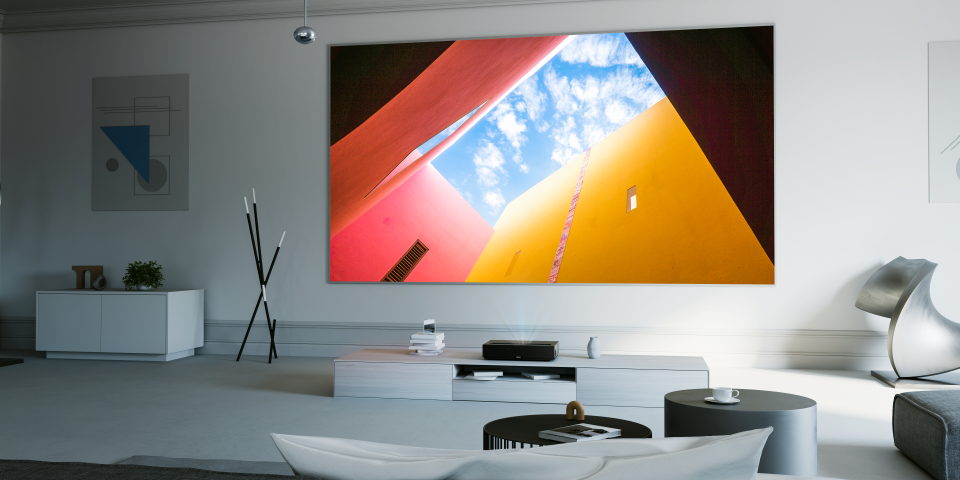Transforming Architectural Design with Ultra-Short Throw Projectors

In the world of architectural design, every detail matters. Designing perfect spaces means putting every square inch of the property into good use, whether it’s for storage, a quiet hiding spot, or adding entertainment value. For Architects designing spaces that captivate and inspire, such as lounges, home theaters, or conference rooms, LCD TVs have played a massive role in dictating the set-up of the room. However, they do come with some limitations.
Ultra-short Throw (UST) projectors have emerged as the beacon of innovation for the limitations posed by traditional LCD TVs. This blog will explore how incorporating UST projectors into their designs has been a game-changer for architects, offering them a palette of new possibilities to reshape the way they approach interior spaces.
LCD Panel Design Challenges
The main design limitation of the traditional LCD panel is its inability to harmonize with the spatial dynamics and intricate details of a well-designed room. The black box cancels out negative spaces in the room while simultaneously reflecting light from every possible source and creating problems for the display’s brightness and contrast levels. The solution to this problem is careful placement of the screen or a UST projector.
UST Projectors are an Architect’s Dream
Architects understand the importance of maximizing space without compromising aesthetics more than anyone else, and this is a factor that has played a huge role in the growing popularity of UST projectors in the design of creative spaces. UST technology has slowly been revolutionizing architectural design by seamlessly integrating itself into design blueprints, giving creatives the freedom to play around and be flexible with the layout of a room and negative spaces without the fear of a solid black mirror taking up a significant amount of space.
Widening the Palette of Possibilities
Oftentimes, the lounge or theater room is where the family comes together to create the most memories in the home, making these the spaces with the most potential to tell stories, invoke emotion, and provoke thought. The architect has to design the space in a way that helps to evoke those emotions and tell these stories. Because UST projectors demand less space in a room than traditional TVs or projectors, they offer creative freedom by being discreetly embedded into the design and blending into the architecture.
By eliminating the need for a large screen, architects can worry less about visible cables and work towards creating clean and uncluttered spaces that are tranquil and foster creativity. UST projectors help architects to bridge the gap between form and function by enhancing the value of minimalism and giving purpose to every element of the design space. A simple living space can be transformed into an immersive environment where life can be experienced to the full.
Formovie THEATER Is a Designer’s Ultimate Companion
The Formovie THEATER makes it possible to squeeze a 150-inch screen into a minimalist room without the fear of a projector hanging overhead, cables running through the room, and a screen taking up a majority of the space. It allows architects to reimagine how people interact with spaces while boasting a stunning 4K UHD display that peaks the room’s entertainment value.
Solving Traditional Problems
The Formovie THEATER utilizes the same light source as cinema projectors to deliver outstandingly bright displays, vivid colors, and high-contrast levels, mitigating the challenges faced by traditional projectors and TV panels. The ALPD laser light source gives the Formovie THEATER 1800 ISO lumens of brightness, a 3000:1 FOFO contrast rate. This enhances the projector’s ability to perform well in well-lit environments, giving architects more flexibility with the placement of the screen and the overall layout of the room.

Learn more about ALPD technology here.
A Complete Sensory Experience
The built-in Bowers and Wilkins speakers complete the minimalist design by delivering a total auditory experience that’s enhanced by Dolby ATMOS. By projecting the image and the sound in opposite directions, the Formovie THEATER eliminates the need for additional surround sound systems while simultaneously enveloping viewers with a stunning symphony of sounds and images. The visual aspect is further enhanced by Formovie’s integration of Dolby Vision, a high-dynamic range format that elevates the number of colors the projector can display, and Motion Estimation, Motion Compensation (MEMC), a technology that delivers a smooth transition of each frame to ensure peak enjoyment of fast-paced action.

Formovie THEATER Limitations
Please note that the projector’s contrast levels are directly related to your screen’s light-rejecting capabilities, and the blacks displayed in the image will only be as dark as your screen permits them to be. To resolve this problem, we suggest incorporating an ambient light-rejecting (ALR) screen into the design, which is available as a bundle when you buy the Formovie THEATER. Alternatively, you can make your screen by painting the wall with ALR screen paint.
Setting New Boundaries
The limitations posed by traditional LCD panels and projectors are no longer a factor that dictates the creative ability of architects. Thanks to the UST projector, aesthetics and function can exist side by side to create extraordinary spaces that transcend beyond entertaining to become a complete part of the home.


